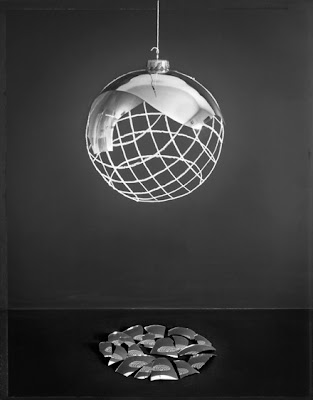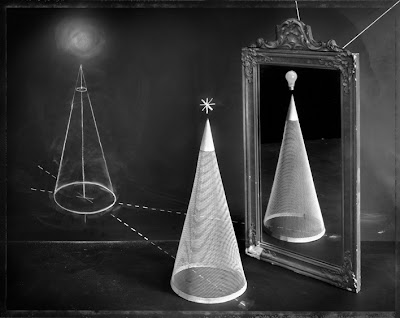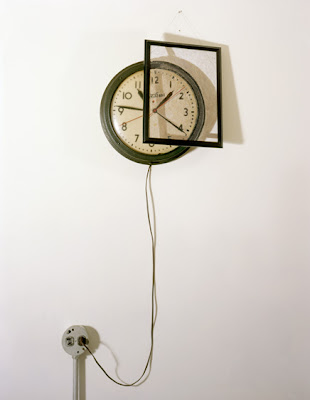Success Stories: John Chervinsky
Exploring the work of John Chervinsky is intriguing and very inspiring as his photographs are a reflection of a thinker and doer. The more I researched John, the more impressed I became by not only his exquisite work, but the level of professionalism and thought he brings to the production, marketing, and execution of his images. As John opens an exhibition of An Experiment in Perspective at the Wallspace Gallery in Santa Barbara, running from May 31st through July 3, 2011, I would, indeed, call John a Success Story.
A self-taught photographer, John brings a host of visual, intellectual, and scientific tools to his work. He is an engineer working in the field of applied physics at Harvard’s Rowland Institute for Science, originally founded by Polaroid’s Edwin H. Land. John spent eighteen years running a particle accelerator at Harvard University and has collaborated with Museums, using accelerator technology in the analysis of art. His work has been celebrated in a number of solo and group shows, and held in significant museum collections across the country.
John has an interesting new body of work, Studio Physics, that is still in production. Examples follow in the interview below.
In 2001, three significant events moved John to retreat to his studio and begin taking his work to another level — his wife became seriously ill, the World Trade Center was attacked, and his friend and fellow photographer Guy Pollard died unexpectedly. This focused time allowed him to find solace in a world that seemed out of control, and create a body of work that is “ an attempt to find metaphors within the laws of nature that can be universally applied to every day life. Conceptually, the work deals with the divide between rational or scientific explanations of existence and man’s need to explain the world around him with various systems of belief. “
His photographic experiment began when he tried to answer the question: “Could one draw a circle in a square corner of a room and still have the circle look round in a photograph?” To create his photographs, John builds vertical and horizontal chalkboard surfaces, then points a view camera at the 90-degree angle formed by their intersection. With chalk he creates markings drawn in projection so it appears, from the viewpoint of the camera, that the markings are floating in space or on the surface of the photograph.
John’s chalk markings—arrows, diagrams, scientific formulae—are juxtaposed with real objects, giving the photographed image an effect that is at once visually unsettling and intellectually provocative. 
Lenses and cameras are the tools of the trade for a working photographer, but it is the field of optics, as it relates to human vision, that can carry with it multivalent symbolic possibilities for the artist. It can stand as a testament to our expansion of human knowledge and perception. It can also symbolize aspects of our weaknesses, thus leading to a greater understanding of the human condition. Are we prone to the same limitations as our trusty camera on a tripod, held to the earth, seeing the universe from a fixed and single point?
First of all, congratulations on your upcoming show at Wallspace Gallery. I appreciate that you are challenging our visual and spiritual limitations with this series. Did you have any new revelations while creating it, or are you exploring territory that is already familiar to you?
Thanks Aline! I feel very fortunate to be at Wall Space amongst some very great artists, and I love working with Crista Dix.
When I first dragged chalkboards into my studio, I knew that I wanted to play tricks with perspective, but that’s all I had in mind. It was mostly unfamiliar territory. I exercise so much control in other aspects of my work, that it would make me unhappy if I controlled the direction too forcefully. I like that period in the course of a project, when the work itself is reflecting something back for me to take hold of. When I first started, I didn’t think the images would have objects at all – only abstract chalk markings. I tried that for a while and it looked terrible. Eventually, I became satisfied with the relationship between object and line and realized that I could then play with symbols and communicate something to viewers.
The biggest revelation with the project, was that it seemed that I could present a fairly ambiguous framework of symbols, and a significant subset of viewers responded to it – and not only that, they did a good job of decoding it. I enjoyed hearing from people who were paying attention to the fact that the tic-tac-toe game in one of my images was an unwinable one; or that those with a scientific background understood the connection between water and the planet Mars.
Is there an image from An Experiment in Perspective that is most meaningful to you?
There is one that features two photographs of my mother; one taken in her 20’s and one taken by me in her 80’s. She is inserted into a mechanics diagram with a physics equation. The image that I created is first and foremost, an expression of my worry about my mother. I also had hoped that the image would serve as a commentary involving the ability of humans to bisect our world along emotional lines and rational lines, simultaneously.
I am very impressed with how you packaged this project as a traveling exhibition (see site for more details). I think we can all learn a lesson from not only your exhibition proposal, but also your approach to showing work. How did this come about?
My very first solo exhibition was here in Massachusetts at the Griffin Museum of Photography in 2005. I hand framed all 23 pieces in the show. Several months later, I attended my very first portfolio review (Photolucida) and made a connection with Mary Virginia Swanson. It was her idea to market the framed pieces as a traveling show. She pointed me to a traveling exhibition organized by the George Eastman House and I wanted to do something similar. I grew up in a very self-reliant household. My father built the house that I grew up in with his own two hands. It was only natural to me, to build the crate. It was a surprising amount of work to complete, but it has been very worthwhile for me. I have to warn that the approach is not for everyone as there are many considerations: storage issues, the intricacies and cost of shipping artwork via motor freight, insurance, etcetera. Like anything else, do your research.
Your amazing print quality is often remarked upon. Are you approaching print making in a unique way or tips you can pass on?
Thanks for that. I don’t know whether my approach is unique but I’m happy to share all. I did come to digital printing with extensive darkroom experience, so it was helpful to know in advance what a good print looks like. I did think that a major weakness of digital printing on matt paper (my choice, for printing images of blackboards) was that the blacks were kind of anemic – and so I spent some time finding an ink and paper combination that produced the deepest blacks that I could get. I found an inexpensive X-rite densitometer on eBay, so that I could make actual measurements. I then figured out a process to have precise calibration for any ink/paper/printer combination. Beyond that, it’s just taking care of basics: starting off with a properly exposed negative, scanning at the highest bit depth possible, avoid having blocked shadows and blown out highlights. For post-process editing, I do rely heavily on the history brush, to finesse my dodging and burning.
You have a fascinating new body of work, Studio Physics. Can you tell us how the new work came about and more about it?
I spent some time thinking about Chris McCaw’s photographs and how he not only created very compelling and beautiful images, pushed his materials to the burning point, actually – but he works at timescales involving hours. It is a time interval that is used in photography, but it is sort of unusual. There are others who work in timescales over years and decades, either studies of people (Nicholas Nixon’s The Brown Sisters, for example) or many who take “then and now” approaches of city shots. I started thinking about a time interval that no one seemed to care about and started thinking about creative ways to exploit that in a still life.
I was already interested in perspective issues with chalk drawing, when I ran into a photographer at Fotofest named Rick Ashley. He used Chinese artists to make straight reproductions of a few of his photographs. There are many commercial painting studios in China that will paint a reproduction of an image that one can send in an email. They can paint a picture of your husband or wife, or they can forge a Van Gogh – you simply have to pay them to do it. It was then, that the idea hit me to use oil painting for my specific purposes.
The idea is to extend the image capture interval from the standard click of the shutter to a period lasting weeks: I shoot a straight still-life, crop the resultant image. I then email a jpeg of the cropped section to China and have them make it into a painting. Meanwhile, my studio setup sits there, but change to it is occurring, the apples begin to rot, the flowers die and the mold advances. Eventually they send the completed painting back to me in the mail. I insert it into the still life, and re-photograph.
Then I just starting having fun! Is the light changing over time? Does the painting fit back into the still life perfectly or can I change its position in space for creative purposes? Does the pull of gravity change an object’s position? I’m hoping to capitalize on, in a very straightforward way, the preoccupation of the physicist: time light space and gravity, and look at them with photography.
How has creating work that takes “not seconds, but weeks” changed your perceptions about making photographs?
Well, only a small subset of objects change noticeably, over weeks – mostly living things, or recently living things. I don’t want the work to be just about decay, however. As in real life, we have growth and decay.
This is a collaborative project–will you ever let your collaborators in on the final product?
Yes, but I’m not in a hurry to tell them. If they find me, so be it. Meanwhile, I’m actually enjoying the challenges of communicating with them. It’s all been very formal, but with broken English and peppered with plenty of exclamation points:
“Thanks for your letter! We are appreciated about your business chance!”
I’ve been trying to get conversational with them to try to find out how many people work at a given facility, what their lives are like, the weather – but those inquiries mostly get ignored. There have been technical challenges associated with the collaboration too – sometimes they’ll change the size of a painting or reorganize the placement of objects, not always in favorable ways. In fact, rarely so.
What advice can you give emerging photographers, especially on presentation, on networking, on consistently producing excellent work?
Well, unless you pay attention to all three aspects, you will only exist at the hobbyist level. At some point in our lives, we have to consider what might happen to our work after we’re gone. You are not Henry Darger. You will not have someone find your work in a shack only to share it with the world. This is not a bleak assessment: more, it is a call to be good not just at one thing, but several.
What opportunity took your career to the next level?
It was not one thing, there are no big breaks, or they are very rare.
Has social networking changed how you promote and market your work?
Yes, and it has made marketing even more perplexing. There are those of my contemporaries that choose to ignore social media entirely, but I believe it is to their own peril. It’s basically too big to ignore: adapt or die. There is power in numbers, however – and if you can crack the Facebook Newsfeed algorithm, you might be able to organize a meaningful strategy.
Do you ever have periods of self-doubt and feel creatively unmotivated?
Yes, but I use that time for technical hacks that might lead somewhere interesting. Recently I learned how to take x-rays in one of our labs. I spent quite a bit of time learning and reading about technique, but I have not yet been able to create a body of work that was compelling enough to share with others. I think it’s important to keep busy and during dry spells. You never know when a simmering pot may boil over.
And finally, what would be your perfect day?
It would involve swimming across Walden Pond with my wife, playing Frisbee with my dog, running up the spiral staircases at the Rowland Institute, shooting “a keeper” in my studio, listening to good music, listening to bad music, fish on the grill, a pint of fine ale, another pint of fine ale. I have lots of perfect days – my needs are simple.
Posts on Lenscratch may not be reproduced without the permission of the Lenscratch staff and the photographer.
Recommended
-
Ricardo Miguel Hernández: When the memory turns to dust and Beyond PainNovember 28th, 2025
-
Pamela Landau Connolly: Columbus DriveNovember 26th, 2025
-
Interview with Maja Daniels: Gertrud, Natural Phenomena, and Alternative TimelinesNovember 16th, 2025
-
Robert Rauschenberg at Gemini G.E.LOctober 18th, 2025
-
Hillerbrand+Magsamen: nothing is precious, everything is gameOctober 12th, 2025



























































































